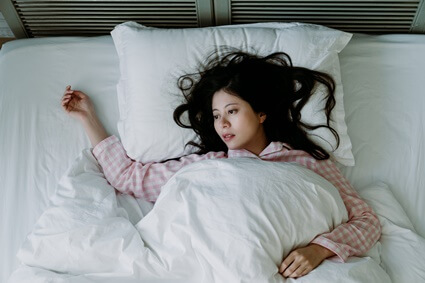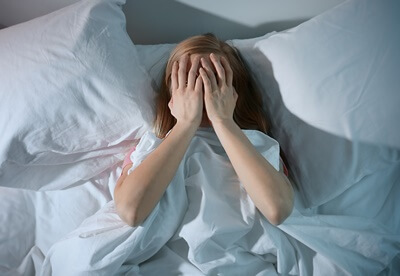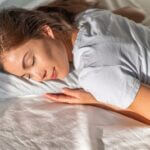Last Updated on February 12, 2024 by Louise Carter
Doing things in your sleep, especially if you can’t remember them later, can be troubling. However, there are several medically defined reasons why some people move and talk while asleep.
These conditions are collectively known as parasomnia. They stop us from sleeping as we should, especially due to movement or talking. The effects vary depending on when they occur in the sleep cycle.
We’ll be exploring what parasomnia is and the symptoms that define it. These could be anything from waking up and not remembering where you are to becoming aggressive.
What Is Parasomnia?
Parasomnias are a group of sleep disorders that occur during sleep and are characterized by movement and activity. This activity is unlike normal sleep activities, like turning and rolling over.
The most recognizable symptoms are as follows:
- Walking during sleep.
- Repetitive actions.
- Performing simple or complex tasks while asleep.
- Being difficult to wake.
- Appearing unresponsive to questions.
- Becoming aggressive, irritated, or annoyed when efforts are made to wake you.
- Waking up and not remembering where you are.
The most common parasomnia is sleepwalking, but there are variations.
REM Sleep Behavior Disorder
It might be a REM sleep behavior disorder if you have conversations while sleeping and don’t remember.
This results in similar but subtly different symptoms to sleepwalking, and it’s also physiologically different, meaning it has various physical causes.
REM sleep, which is also colloquially referred to as light sleep, is the kind of sleep in which you can dream. It’s easy to recognize when somebody is in REM sleep.
You can see their eyes moving around aimlessly. They may also mumble and murmur, although they don’t speak clearly. This is the stage during which REM sleep behavior disorder, or RBD, can happen.
During normal REM sleep, muscle atonia occurs, which means the muscles become slack and can’t move. However, this doesn’t happen in REM sleep behavior disorder.
The person with RBD can act out their dream, which can lead to certain behaviors, including:
- Whispering, talking, shouting, and screaming in your sleep.
- Thrashing aimlessly.
- Co-ordinated movements.
- Fighting, as if fighting somebody in a dream.
A person acting out their dream won’t always remember certain things.
Unlike sleepwalking, people with RBD can be woken up and may awaken themselves once they try to stand up. This usually occurs early in the morning, which is when people typically get REM sleep.

What Are The Causes?
Studies link RBD with certain degenerative neurological diseases. These are chronic conditions where the brain slowly deteriorates, including Parkinson’s disease and dementia.
According to Neuroethics, two-thirds of people who experienced RBD went on to be diagnosed with a degenerative condition.
Scientists believe this may be due to Lewy bodies, which are abnormal brain lesions. These are deposits of protein that grow slowly and destroy brain tissue.
Over time, this leads to a deterioration seen in conditions like Alzheimer’s disease. At this point, scientists are unsure why they occur.
Real-Life RBD Examples
During RBD, your behavior is erratic and appears out of context because you’re acting out a dream. The examples of what you do during RBD are limited only by the creativity of your dreams.
If you exhibit any of the following behaviors, the problem may be RBD:
- A movement like kicking and punching, as if fighting somebody in a dream.
- Flailing, moving your legs, or jumping out of bed during a chasing dream.
- Making noises, like laughing, crying, moaning, cursing, or shouting.
If somebody wakes you from your dream, you may be able to remember aspects of the dream. These are usually snatches of the narrative, not full recollections.
If you aren’t fully awake, you won’t be able to remember the behavior in the morning.
RBD Treatments
Treatment for parasomnia is effective if you identify the parasomnia affecting you.
Parasomnias are divided into REM sleep disorders and NREM (non-REM) sleep disorders. Any problem during deep sleep or any stage of sleep other than REM is considered NREM.
Clonazepam
Non-pharmaceutical options for the treatment of parasomnia are limited.
Clonazepam is sold under the brand name Klonopin, among others. It’s usually used to prevent seizures and panic disorders. However, as a general tranquilizer, it’s effective against parasomnias.
According to the journal Psychiatry (Edgmont), Clonazepam is effective in up to 90% of cases. Patients take between 0.5 and 1 mg of Clonazepam before bed, which is usually enough to prevent parasomnia.
Toleration doesn’t occur through Clonazepam, so it’s a viable long-term solution.
Melatonin
Melatonin is a hormone produced to regulate sleep and wakefulness over a day.
Melatonin supplements are used to aid sleep, with positive results. According to the study above, 3-12 mg of melatonin can be effective, especially when combined with Clonazepam.
Pharmaceutical Aids
Tricyclic antidepressants, levodopa, and dopamine agonists may also be effective.
NREM Sleep Disorders
NREM sleep disorders occur while the body is in deep sleep (or slow-wave sleep).
Slow-wave sleep (SWS) is low brain activity measured in Hz (Hertz), a measure of frequency in cycles.
The brain is mainly inactive during regular SWS, as you don’t dream, think, or move. When you’re awoken during this phase, you can act strangely.
Sleepwalking
According to PLoS One, sleepwalking (somnambulism) is relatively uncommon. The lifetime prevalence of sleepwalking is 6.9%, although it’s more common in children.
There are no health problems associated with sleepwalking. Waking a sleepwalker while they’re sleepwalking can’t cause health problems, but they may become aggressive if you restrain them.
Sleepwalking can be mild or severe; normal cases involve walking around and performing actions. However, more difficult cases can involve driving and violence.
The activity of the sleepwalker seems to be guided by their dream.
According to Sleep, 71% of sleepwalkers could recall a dream associated with their actions; 24% involved aggression toward the sleepwalker, 54% involved misfortune, and 84% involved apprehension.
Not all sleepwalkers dream or can recall episodes of activity in the morning. If awakened by somebody else, the sleepwalker often remains confused and disoriented.
What Are The Causes?
Sleepwalking is caused by partial arousal (i.e., awakening) during slow-wave sleep.
During sleepwalking, the brain remains active in some ways but not others. According to Neuroethics, the body physically prepares itself to enter the deepest stage of sleep.
This involves almost completely switching off sensory perception, hence why it’s difficult to wake a sleepwalker—they can’t see, hear, smell, or feel anywhere near as well as when awake.
Other kinds of brain activity don’t switch off. In particular, motor activity continues. This means that a sleepwalker can still talk and move.
Electroencephalograms—measurements of brain activity—show a mixture of sleep and wakefulness brain patterns. However, why this occurs is unclear.
Sleepwalking Examples
Sleepwalking isn’t just about walking around. There are a variety of movements and behaviors associated with sleepwalking, so you might:
- Walk around to perform a task or as if searching for something.
- Walk around before standing still and staring into the distance.
- Perform simple or complex tasks.
The majority of sleepwalkers walk around in a confused state.
Most people grow out of sleepwalking once they reach adulthood.
Confusional Arousal
The problem may be confusional arousal if you wake up confused and disoriented.
Confusional arousal occurs when a person wakes up at night but not completely. During this time, they feel confused and disoriented.
The feeling is similar to that of a sleepwalker when they wake up. However, they aren’t necessarily associated with as much activity as sleepwalking. They result in the following:
- Slow and slurred speech for an extended period.
- Muddled and confused thinking.
- Poor memory—not remembering where you are or what you’re doing.
Confusional arousal results in some activity. For example, they may perform small hand movements that wake up a sleeping partner, like picking at the bedding, poking, or moving backward and forward.
The confusion begins when a person tries to wake up the sleeper. This could be for any reason, which means the sleeper may be thrashing, talking loudly, or acting strangely.
Upon waking, the person goes through the confusional arousal described above. In rare cases, a person with confusional arousal may be aggressive and try to fight the person waking them up.
People who experience confusional arousal won’t remember the episode by the morning.
Confusional Arousal Causes
The cause of confusional arousal is unclear, but it may be triggered by things that make deep sleep deeper than usual.
According to Neurotherapeutics, they can be triggered by polyneuropathy, which involves many medications that alter brain function.
If this isn’t the case, the problem could be caused by taking natural and pharmaceutical sedatives.
Confusional Arousal Examples
Confusional arousal is like a bridge between sleep and wakefulness. Examples are odd and based on dreams. You may wake up thinking that:
- There are beetles, snakes, or flies in the bed.
- You’re somewhere that you’re not.
- You’re fighting or arguing with somebody.
Nocturnal Sleep-Related Eating Disorder (NS-RED)
A nocturnal sleep-related eating disorder isn’t just basic nighttime snacking.
It’s a variant of sleepwalking, but the behavior means that the person is driven to eat. During the night, they’ll rouse for whatever reason, and once roused, they’ll be unable to sleep well until they eat.
The person will automatically head to the kitchen to find food, leading the person to cook. The person will be barely aware of their actions.
NS-RED Causes
Neurotherapeutics stated that NS-RED can be an offshoot of sleepwalking and confusional arousal.
It’s essentially caused by competing brain functions, some awake and some asleep. However, there are also hormonal and biological causes at play.
In normal sleep, the body enters a prolonged fast. The body maintains energy homeostasis by using little energy during sleep. The metabolism slows down, and the appetite disappears. This state lasts until the morning when you get the desire to eat breakfast.
This is in contrast to the body’s activity during the day. Your body demonstrates progressive hypoglycemia over 12 hours of fasting during the day.
In those with NS-RED, the body’s appetite continues to be affected at night. After a person is roused, they’ll experience a strong desire to eat.
People with the condition describe their actions as involuntary and impulsive. In most cases, the person is aware but not in control of their actions.
However, amnestic NS-RED involves eating without being aware. The person can’t remember what happened during the night. If you’re eating during the night, this is likely the problem.
Sexsomnia
Sexsomnia is a variant of sleepwalking and confusional arousal.
However, the behavior exhibited by people with sexsomnia is primarily or solely sexual. This could include attempting sex with a partner in bed or masturbation.
Sexsomnia is a variant of confusional arousals and sleepwalking. It occurs during periods of slow-wave sleep rather than REM sleep.
You will have forgotten an episode of sexsomnia by morning.
NREM Sleep Disorder Treatments
Conditions like confusional arousal don’t cause you to wake up by yourself. Something causes you to wake up, after which confusional arousal occurs, and the same applies to sexsomnia and NS-RED.
Addressing the cause of arousal prevents the condition from affecting you. There are many natural and non-natural ways to do this, including:
Making Noise
Masking or blocking noise will prevent you from waking up as often. Options include earplugs, earmuffs, white noise, noise-blocking curtains, and wall panels.
Supplements
Many natural supplements can sometimes help you benefit from deeper sleep, which can help prevent arousal. These supplements include:
- Melatonin.
- Valerian Root extract.
- Kava.
- L-tryptophan.
You may also want to try herbal teas, which help people sleep more deeply. However, they can have diuretic effects, which may mean that you wake up to go to the toilet.
Sleep Hygiene
Good sleep hygiene enables people to resynchronize their sleep clock, preventing them from waking up during sleep.
Good sleep hygiene practices include not using screens before bed, making your bedroom more comfortable, and having a routine.

Which Parasomnia Do I Have?
Identifying what’s wrong isn’t easy because the conditions overlap.
For example, sexsomnia is a variant of sleepwalking or confusional arousal. For the person experiencing the issue, each condition feels similar, too.
How can you tell what the problem is?
Request Assistance
Since you’re asleep, figuring the problem out for yourself is impossible.
Ask your partner more about what you do and say while asleep. If you live at home, a family member, roommate, or housemate may also be able to help.
Whatever the case, you can ask them for information to guide your research, such as:
- When the problem starts, are you dreaming? Ask them whether your eyes are moving, which is a characteristic of REM sleep.
- Do you talk, or do you talk and move? Normal muscle atonia may occur during REM sleep if you don’t or can’t move.
- Have you ever exhibited behaviors of sexsomnia or nighttime eating?
Their answers should narrow down the cause.
Polysomnography
Polysomnography (PSG) is the medical study of sleep. It’s a test with multiple parameters (things that you measure) performed overnight at a hospital or clinic to identify sleep problems.
During the test, you lie down in a bed and fall asleep. However, your breathing rate, heart rate, muscle activation, eye movements, and brain activity level will be monitored.
Polysomnography will clarify the difference between the parasomnias above.
REM sleep behavior disorder appears different on an electroencephalogram (EEG—brainwave monitor) to other parasomnias because your body is in a different stage of sleep.
Start by avoiding waking up at night with supplements and noise blocking/masking. If that’s ineffective, a doctor may be able to prescribe you Clonazepam to tackle parasomnia.







